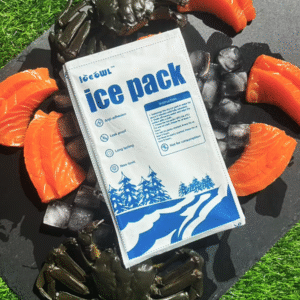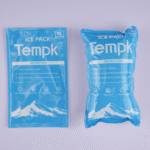How Medical Supply Dry Ice Packs Ensure Safe and Efficient Cold Chain Shipping
In the pharmaceutical and medical industries, ensuring that temperature-sensitive products such as vaccines, biologics, and blood samples maintain their efficacy during transport is paramount. Medical supply dry ice packs play a crucial role in achieving this goal by providing the necessary subzero temperatures to keep these products stable. Dry ice, sublimating at a temperature of -78.5°C (-109.3°F), offers the most reliable cooling method, particularly for products that require frozen conditions. This guide will explore the benefits of using dry ice packs, how they work, and how to select the best solution for your medical shipments.
-
What are medical supply dry ice packs, and how do they work in cold chain logistics?
-
How do medical supply dry ice packs maintain temperature stability during transport?
-
What are the main benefits of using dry ice in the shipping of medical supplies?
-
How can you select the best medical supply dry ice packs for your shipments?
What Are Medical Supply Dry Ice Packs, and How Do They Work?
Medical supply dry ice packs are solid blocks or sheets of carbon dioxide (CO₂) that provide cooling at extremely low temperatures. These packs are unique because they sublimate directly from solid to gas, absorbing heat from their surroundings and creating a cold environment that is essential for the stability of vaccines, blood samples, and other biologics. Unlike traditional ice, which melts into water, dry ice leaves no residue, making it a cleaner and more efficient option for medical shipments.
This sublimation process ensures that dry ice packs can maintain temperatures as low as -78.5°C (-109.3°F), a range perfect for the most sensitive products. When packed in insulated containers, these dry ice packs can maintain consistent cooling over long transport times.
How Do Medical Supply Dry Ice Packs Maintain Temperature Stability?
Dry ice packs maintain temperature stability during transport by absorbing heat from their surroundings as they transition from solid to gas (sublimation). This process lowers the temperature inside the shipping container, keeping medical products at the required low temperatures.
The key factor is the sublimation point of dry ice—which is much lower than typical refrigerated or frozen solutions. Dry ice sublimates at -78.5°C (-109.3°F), which is essential for preserving biologics and vaccines that require ultra-cold storage. This extended temperature control ensures that the medical products remain viable for longer periods, which is especially important for long-distance or international shipments.
Key Benefits of Using Medical Supply Dry Ice Packs
When transporting medical supplies, dry ice packs offer numerous advantages:
-
Extended Cooling Duration: Dry ice maintains extremely low temperatures for 24-48 hours, sometimes longer depending on the size and packaging, which is ideal for shipments requiring long-term cooling.
-
Non-Toxic and Safe for Transport: Unlike other hazardous materials like liquid nitrogen, dry ice is non-toxic, making it safer to handle when proper precautions are taken. It is also a safer option than ice, which can create moisture and compromise the integrity of the medical supplies.
-
Efficient Space Usage: Dry ice packs are compact and can be easily integrated into shipping containers, optimizing the space available for transporting medical products.
| Benefit | Dry Ice Packs | Gel Packs | Ice Packs |
|---|---|---|---|
| Temperature Control | Maintains freezing conditions | Suitable for short-term cooling | Effective for short-term cooling |
| Cooling Duration | 24-48 hours | 6-12 hours | Varies |
| Cost-Effectiveness | High cooling efficiency | Less efficient | Less effective for long shipments |
| Suitability for Sensitive Goods | Ideal for vaccines, blood, biologics | Best for non-critical items | Suitable for less delicate goods |
How to Choose the Right Medical Supply Dry Ice Packs
Choosing the correct medical supply dry ice packs depends on your specific shipping needs:
-
Product Temperature Requirements: Understand the temperature range that your medical products need. Some products, such as certain vaccines, require deep freezing, while others may only need refrigeration.
-
Shipment Duration: If you’re shipping for an extended period, it’s crucial to consider larger or additional dry ice packs to ensure the required temperature is maintained throughout the shipment.
-
Environmental Conditions: Keep in mind that external factors like temperature and humidity can influence the sublimation rate of dry ice. For instance, in warmer environments, you may need more dry ice or enhanced insulation to maintain stability.
Real-Life Applications of Medical Supply Dry Ice Packs
Medical supply dry ice packs are commonly used in various real-world applications to ensure that medical products remain within the required temperature range during transport:
-
Scenario 1: Shipping Vaccines Across Countries: A pharmaceutical company needs to ship a batch of vaccines. Dry ice packs are used to keep the vaccines at the required freezing temperature, ensuring they arrive safely and remain effective.
-
Scenario 2: Transporting Blood Samples for Research: A hospital needs to send blood samples for testing. Dry ice packs are used to keep the samples frozen, preventing degradation or loss of viability.
Key Considerations When Using Medical Supply Dry Ice Packs
While dry ice is highly effective, there are important considerations:
-
Safety Measures: Always handle dry ice with care, wearing insulated gloves to prevent frostbite. Ensure proper ventilation to avoid CO₂ buildup.
-
Proper Packaging: Ensure that medical supplies are securely packaged to prevent damage and that dry ice is packed in a way that maintains its effectiveness throughout the journey.
-
Regulations: Dry ice is classified as a hazardous material and must be properly labeled according to DOT regulations when shipped.
2025 Trends and Developments in Medical Supply Shipping
As we approach 2025, there are several trends shaping the future of medical supply shipping and cold chain logistics:
-
Sustainability in Dry Ice Production: There is a growing demand for eco-friendly dry ice solutions. Companies are exploring methods to capture CO₂ from industrial processes and use it to create carbon-negative dry ice.
-
IoT-Enabled Temperature Monitoring: The use of IoT technology for real-time monitoring of temperature conditions is enhancing transparency and compliance in medical shipments.
-
AI-Optimized Logistics: Artificial intelligence is improving route planning and dry ice allocation, ensuring the most efficient use of resources and minimizing delays.
Latest Developments Overview
-
Carbon-Negative Dry Ice: Using CO₂ from captured emissions helps reduce the carbon footprint of dry ice production.
-
Smart Packaging: Integration of temperature sensors and QR codes allows for real-time monitoring and greater visibility.
-
Sustainability Focus: A move toward biofoam and other sustainable packaging materials is making the cold chain industry more eco-friendly.
Frequently Asked Questions
Q1: How long do medical supply dry ice packs last during shipping?
Dry ice packs last 24 to 48 hours, depending on the size of the pack, insulation, and external conditions.
Q2: Can dry ice be used for shipping biological samples?
Yes, dry ice is commonly used for shipping biological samples such as blood and tissues, as it maintains the necessary freezing conditions.
Conclusion and Recommendations
In conclusion, medical supply dry ice packs are indispensable for cold chain logistics. They offer reliable cooling that ensures the integrity of sensitive products like vaccines and biologics during transport. By using dry ice, businesses can minimize spoilage, reduce costs, and enhance the efficiency of their shipping operations.
Next Steps: How to Implement Dry Ice Packs for Your Medical Supply Shipments
To implement dry ice packs effectively:
-
Assess your products’ temperature requirements and choose the right dry ice solution.
-
Train your staff on the safe handling of dry ice and ensure they understand regulatory compliance.
-
Ensure proper packaging to protect both the dry ice and the medical supplies during transit.
For further guidance, please reach out to us for expert advice tailored to your specific needs.























